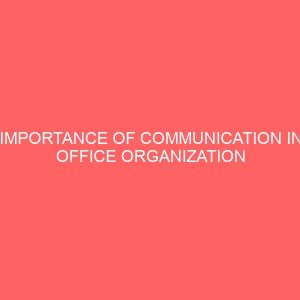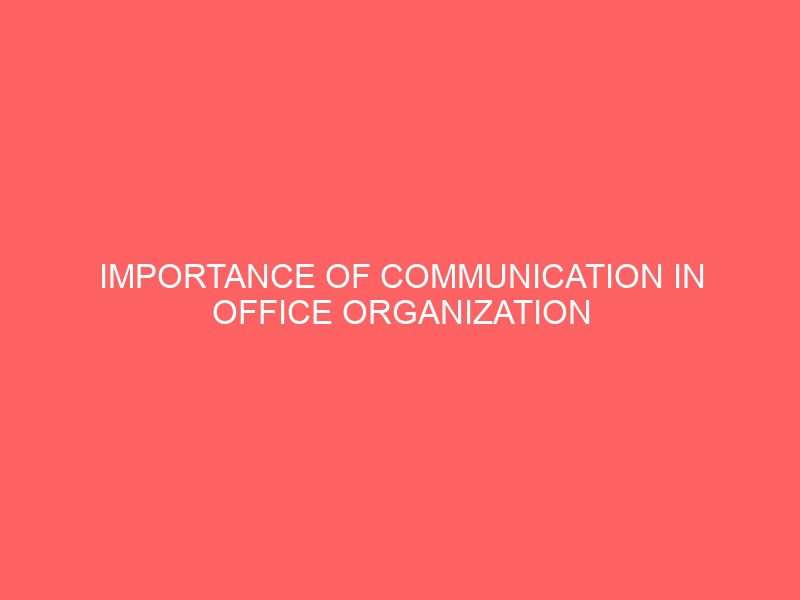Description
Importance of communication in office organization
CHAPTER ONE
INTRODUCTION 1.1
BACKGROUND OF THE STUDY
Generally, people frequently need to coordinate their activities in order to do their work. The history of communications which as an integral part of public relations is as old as the human race. It is an important factor in all human behavior. Communication has contrived to grow among members of various organizations be it political, social, religions and business and also for the economic development of human beings communication therefore, is a very broad concept and is capable of engendering varied interpretations. However, for a communication to be meaningful and achieve its intended purpose, it has to contain the seven (7) stages of communication (Okoro and Nwadukwe 1998). These stages of communication according to them are: Credibility, context, continuity, content, consistency, channel, and capability of audience. Additionally, communication has many definitions it means various things to different people. Each communication specialist defines it to suit his write-up. To some, it may include equipment used in passing information such as telephone, television, telegraph or computer communication system in the organization such as the formal chain of command, grapevine, the complaint box and the grievance procedure. Meanwhile, we can say without doubt that communication by which organized activities are unified according to. Garside (1986) remarked that communication is the sharing of ideas and feeling in a mood of mutual understanding; a two way process in which accurate information is being transmitted from the mind of the sender to the mind of receiver. It is on this basis that little (1965) describes it as. “The process by which information is passed between individuals and/or organization by means of previously agreed symbols such as words, figures, Charts, Pictures, Gestures, Drawing, etc. The above brief discussion of communication emphasizes its importance in human interaction in other words, no organization can survive without communication. The diagram below depicts a basis communication cycle by Desmond Evans. The cycle has six (6) stages, called stages.An effective communication is always in two processes; to the receiver and back to the sender.
Furthermore, F.UBalogun, J.O. Ikupa and U.E. Chinyere in the course of writing book shed more light on the communication cycle which they propounded.
STAGE ONE: MESSAGE CONCEIVED (PLAN): This is the stage of which the communicator finds it necessary to share a thought. At this stage, the communicator who must have been involved in intrapersonal communication decides that he needs to communicate with somebody else, the decoder/communicate.
STAGE TWO: MESSAGE ENCODED: As soon as the decision to communicate is reached, the encoder encodes his message in the language that is appropriate to the situation and audience and transmits same through the right channel/or medium to avoid communication breakdown.
STAGE THREE: COMMUNICATION MEDIUM CHOSEN: This is the stage at which the encoder or transmitter choses the mode and medium of communication. He decides whether the message should be in written, oral or visual form as well as the vehicle to transmits it – radio, telephone, leter, electronic mail, face – to – face conversation, circular, memo, conference, meeting, etc.
STAGE FOUR: MESSAGE DECODED (MEANING):This refers to the assimilation of the message by the decoder or receiver. In order words, there must be mutual intelligibility between the sender and the receiver for the message encoded to be properly decoded.
STAGE FIVE: INTERPRETATION: The interpretation stage is an integral part of the process of decoding. In other words, decoding a message involves comprehension and interpretation. It is accurate interpretation of the message.
STAGE SIX: SUPPLIED (FEEDBACK): This is the stage at which sender is assured that his message has been received and acted upon because he gets a response from the receiver. NOTEthat feedback may take any of these forms: a nod, shake of hands, a smile, a written/verbal response, an angry outburst, silence, a frown. Basically, there are several ways by which people can communicate with each other. These can be classified into verbal and non-verbal means, which include body movement, physical characteristics, touching, behaviours and paralanguage. There are several forms of language such as the computer language (program) and system of mathematics notation. For the purpose of this research work, language will only be regarded as important tool on both written and spoken as there are many tribes the world over and hence it is necessary that the encoder of an idea should use the language that could be understood what the sender intended in the way or the manner the sender communicate; them. Experiences have shown that the percentage of time allocated to communicationis very high ranging from 75% to 100% working hours; 50% in talking and 50% in listening Barels Alex and Berreth Demot, (1951). From all evidence shown, communication is of paramount importance in dealing with the human factor throughout his stay in the organization – from recruitment to retirement. Furthermore, communication combines management functions and relate it to both internal and external environment. Every system is to accomplish its purpose. Communication provides information that simultaneously guides the system towards organizational goal achievement. Finally, communication can be viewed as an elaborate system for gathering, evaluating, recording, and disseminating information. Hence it is not fallacious to say that there will be no organization if there is no effective communication.
1.2 STATEMENT OF THE PROBLEM It is clear to say that information is the life wire behind the survival of any business organization. Distortion and inadequacy of information have led to several ugly situations consequently, strike actions, work to rule and sit down have resulted from inadequate communication system. Experience has shown that delay in communication procedure endanger effective management. As a result of this, problem or misunderstanding usually arise between management and different department in an organization. Problems arise in an organization when the need and aims of communication for both employers and employees are at variance with each other. Therefore, for a communication system to be successfully met and satisfy an organization’s aspiration the organization must have its goals well defined and articulated.
1.3 PURPOSE OF THE STUDY The primary purpose of this research work is to conduct a study of the relevance of communication as a tool for effective management. It is therefore believed that the study will achieve the following: 1. To identify the problems of communication in the Delta State Polytechnic, Ozoro. 2. To identify how communication system helps in the achievement of organizational goals. 3. To find out whether delay in communication procedure endangers managerial effectiveness. 4. To provide long-lasting solution to these problems. 5. To find out whether inadequacy and distortion of information can lead to strike action, work to rule and sit down. Based on the findings, recommendation will be made on how to install effective communication so as to improve the imaged and efficiency of the organization.
1.4 RESEARCH QUESTIONS 1. Can poor listening impose a barrier to effective communication?2. Is there any effect of improper selection of medium on effective communication?3. Is there any difference in the ways information is being communicated to both management and the employees? 4. Does noise constitute distortion to effective communication?
1.5 RESEARCH HYPOTHESIS Ho: There is no significant relationship between communications in office organization. Hi: There is a significant relationship between communications in office organization.
1.6 SIGNIFICANCE OF THE STUDY It is hoped that a study on the “Importance of Communication in an Office Organization” will be of great importance in the following ways. v The study will help prospective business men to know the cause and reasons of communication. v The importance of communication cannot be over-emphasized. To this end, to say that the survival of any business organization depends to a large extent, on the communication is not an overstatement. Management strives relentlessly to maintain goodcommunication goals which could easily be attained. v The study will also be useful to theeducated elites who rain and educate students in business studies, so as to expose them to other areas of communication. v The study will help further researchers in similar field who would find it invaluable as a document of reference. v Finally, the student of management studies will also benefit from this study simply because it will expand their knowledge and their scope of understanding of communication.








Reviews
There are no reviews yet.